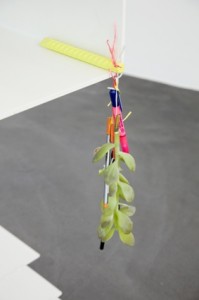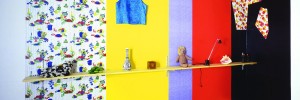(ANNANDALE-on-HUDSON, N.Y.) – Exhibitions featuring works by contemporary artists Haim Steinbach and Helen Marten go on display at Bard College’s Center for Curatorial Studies (CCS) on Saturday, June 22, 2013, with an opening reception from 1 to 4pm. The shows will run through the summer, and in the case of the Steinbach exhibit, through the end of the year. Steinbach’s once again the world is flat., curated by Tom Eccles and Johanna Burton, is in Bard’s Hessel Museum of Art. Marten’s No borders in a wok that can’t be crossed, curated by Beatrix Ruf, is in the CCS Bard Galleries.
Comprising a number of Haim Steinbach’s grid-based paintings from the early 1970s, as well as a series of reconfigured historical installations and major new works created in relation to a selection of works drawn from the Marieluise Hessel Collection, the artworks in once again the world is flat. span Steinbach’s forty-year career. Known primarily for his paradigmatic shelves displaying everyday objects, once again the world is flat. offers a significant opportunity to reconsider the trajectory of this seminal artist’s work, through its evolution from early paintings to the later large-scale installations that have seldom been seen and are less known in the United States. In these installations, Steinbach privileges the mechanisms of display, a concept he has employed since the late 1970s: highlighting the selection and arrangement of objects, while providing new and unexpected psychological, aesthetic, cultural, and ritualistic aspects of the displayed works, as well as the context in which they are presented.
Haim Steinbach was born in 1944 in Rehovot, Israel. He has lived in New York since 1957. He received his BFA from Pratt Institute in 1968 and his MFA from Yale University in 1973. Until the mid-1970s he produced paintings that, responding to minimalism’s limitations, examined the codes of visual language through a calculated placement of colored bars around monochrome squares. He abandoned painting for a series entitled Linopanel, using linoleum as a material that mirrored cultural traditions of flooring (Rococo patterns, Colonial wood, generic tiling, etc.). In the late 1970s his practice delved into spatial questions of visual syntax, honing in on the quotidian rituals of collecting and arranging objects through a continued engagement with the Display works. His presentation of found, bought or gifted objects alters the lens of cultural histories, mapping otherwise concealed bonds of attachment and desire between object, place and viewer.

Helen Marten
A face the same colour as your desk (6), 2012 (detail)
Welded/radial bent powder coated steel; stitched fabric;
chocolate; cigarettes; cactuses; fruit; grinded rebar;
plastic string; wood; pens; cardboard90 x 60 x 70 cm; 35 1/2 x 23 2/3 x 27 1/2 in
Courtesy of the artist, Johann König, Berlin and T293
Rome/Naples
Photo: Annik Wetter
No borders in a wok that can’t be crossed marks the first U.S. museum exhibition of British artist Helen Marten. It also marks the first major collaboration between CCS Bard and the Kunsthalle Zürich, a configuration of which was presented as part of the inaugural program of the Kunsthalle’s newly expanded Löwenbräukunst complex in 2012.
For No borders in a wok that can’t be crossed, Marten has created a group of works, which interweave the diversity of her work in terms of media – from sculptures to wall pieces and videos – in a comprehensive installation including many new works created specifically for the CCS Bard exhibition.
Marten’s work offers a disconcerting experience of material, symbolic and linguistic collapse. Entwining real surfaces with implied linguistic scenarios, Marten pokes humorously at questions of ownership and dishonesty in materials, the relationship of object to artifact, and of package to product. Interested in the grammatical approximations made in workmanship, Marten’s exhibition weaves constant conversations between counterfeit and camouflage. The idea of tracing around the outlines of substance – of hinting at recognizable information through disrupted form – is one that gives authority to the wonky, to the drunken and the misaligned. Image is continually tripped up by language, by a deliberateness of error that postures with all the concrete certainty of cultural recognizability. All plausible facets of the gallery space are treated with equal consideration, with emphasis on the thought that the speed of delivery of an object might reveal different formal relationships.
Helen Marten (born 1985, Macclesfield) lives and works in London.
Guided public tours every Saturday at 1pm during the summer – for more information contact ccs@bard.edu or 845.758.7598.
The Center for Curatorial Studies at Bard College (CCS Bard) is an exhibition, education, and research center dedicated to the study of art and curatorial practices from the 1960s to the present day.

